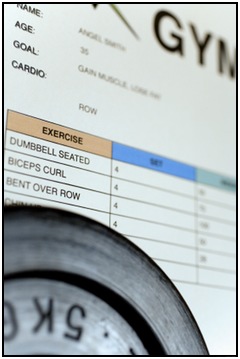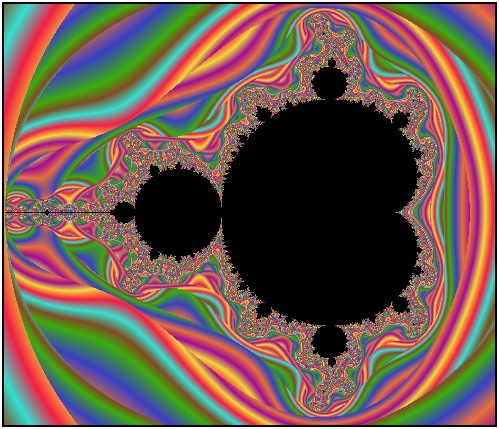The Weight Training System
That Works Best For YOU
With a good weight training system you can make tremendous progress. And without one you just sort of… don't… go…. anywhere.
Weight training is one of the best methods of strength training! If you want to start weight training safely and effectively, with the best info, diet, and routines, check out the 5 Day Beginner Weight Training Course!
What A Good Weight Training System Gives You

Any good training system is…
- A set of components working together to form a complex whole.
And my personal opinion…
- A true system delivers predictable and repeatable results.
A computer system can predictably and reliably give you the template for a document, perform a calculation, or allow you to perform certain actions (open a file, check you e-mail, view naughty photos online, etc.). And a good weight training system will give you predictable, repeatable changes to your body.
Somebody else using the system should get the same or very similar results. For a weight training system, this applies within the context of the person (genetics, training history, etc.).
And The Components Of An Effective System
An effective system of weight training optimizes and harmonizes your…
- Weight Training Frequency, Lifts, and Duration
- Food and Food Timing
- Rest and Recovery
- …And Possibly Supplements
When you have all four of these aspects working together, you can make massive muscle gains very fast. If you get only one right it's better than nothing, but you definitely won't get your best results.
By keeping all of these at their peak with some intensive management, I was able to add 5 pounds of muscle in one month, November of 2011.
What did I do? I used excellent nutrition with a healthy low carbohydrate diet, ate my protein, used an intense but brief workout, and left lots of time to rest and recover. On the face of it - pretty simple; but it's the nuances of each of those four categories that I’ve separated out, above, that allowed me to make such rapid gains.
Perhaps not as impressive as what you hear about on infomercials, but these results are real. And 5 pounds is a lot of meat.
What Weight Training System
Works Best For You?
Above all, choose a weight training system that accommodates you. You might want to do a CrossFit style workout - but if you're a busy executive who can workout only once a week for a short period of time, that might not be the best choice.
Simple, well-designed beginners weight training workouts will give you a great foundation and can keep you going for six months to a year. Though if you take your workouts seriously and stick with them, you'll develop your own personalized weight training system.
Also, don't fall into the trap of practicing the same specialized weight training system that an Olympian or Arnold Schwarzenegger used and then expect the same results for yourself. They have very different genetics that you do. (If you are an Olympian, please disregard that above statement.)
This is the sort of mistake that makes people take up swimming because they want to develop a 'swimmer's body'. It doesn't occur to them that the people at swim meets might look the way they do because they inherently have bodies built for swimming, and people with bodies not build for swimming don't make it to swim meets.
A Fractal Weight Training System?
This is the sexy new method of weight training on the block. And it's actually quite simple and relaxed, despite the geeky name.
First, a fractal is, in the words of their conceiver Benoit Mandelbrot, "a rough or fragmented geometric shape that can be split into parts, each of which is (at least approximately) a reduced-size copy of the whole."[1] So, each piece of the whole looks like the larger picture, but not exactly, and the pattern keeps repeating, but with elements of randomness (chaos).
Whoa! OK, for an easier perspective, take a look at the photo below which is a variation of the famous 'Mandelbrot Set' (guess who it was named after).

Now, take a look at some of the video below. It zooms in on the Mandelbrot fractal, showing its continually repeating nature - though it never repeats exactly.
But fractals are more than geometry. They refer to anything in life that follows self similar (though non-repeating) chaotic patters - in social science, wealth distribution, and (intriguingly) in the geography of fjords.
Nassim Taleb examines this idea at length in The Black Swan, talking about how many social phenomena (such as the duration of wars) have fractal distributions.[2] So fractal statistical distributions are not confined simply to pretty pictures.
And for us, your body has some aspects of the fractal distribution. Your heartbeat is constant, but not exactly the same each time. Your heartbeat is a fractal.[3]
And many other aspects of your physiology are fractal. So, why not train in a fractal manner?
Here's How You Create A Fractal Weight Training System...
It's quite simple, really. When you workout you go all the way, a full kamikaze 100%. But you do those workouts less often, say once a week.
Or twice a week if you're feeling energized. Or you might even go for 2 weeks without a workout if you are super busy, have business trips scheduled, etc. The point is to keep the fundamentals of a really intense workout going to total muscle fatigue and failure, but keeping those workouts irregularly spread apart - and often with more rest than you would think.
Sports that have a fractal training element would be basketball, football, and sparring in martial arts. All of these activities have periods of intense activity and effort interspersed with usually greater recovery time - but those periods aren't too routinized.
Of course, you keep a weight training journal to track your workouts and see how you're progressing. But beyond that, your workouts have an element of the chaotic about them.
And the same is true for your eating with fractal training. Some days you eat too little, some days you overeat (Thanksgiving), some days you have one big meal, some days you have more small meals. And sometimes you fast.
The Best Weight Training System For YOU Is...
You'll have to do some experimenting on yourself to find what works best for you. There's a lot to eating and exercising to transform your body into exactly what you want.
This course gives you basic weight training programs which will give you results, as well as the tools to develop your own weight training system. Try it.
Oh, and be sure to sign up for the e-zine Starting Strong to get monthly strength training, exercise, and diet tips e-mailed to you - and access to the free e-book Train Smart, Eat Smart: Exercise Nutrition Hacks!
• Click here to learn more about Weight Training for Beginners!
OR
References:
1. Mandelbrot, B.B., 1983, The Fractal Geometry of Nature (Updated and Augmented). New York, W.H. Freeman and Co. Pp. 468.
2. Taleb, Nassim. 2007. The Black Swan: The Impact of the Highly Improbable. New York: Random House. Pp. 271.
3. De Vany, Arthur. 2011. The New Evolution Diet: What Our Paleolithic Ancestors Can Teach Us About Weight Loss, Fitness, and Aging. Emmaus, Pa: Rodale. Pp. 117.
Search CST...
|
Tweet Follow @Aaron_CST |
|
"About 2 weeks ago I read all the ab strengthening stuff on your site because I decided I wanted to be strong, instead of having a lot of belly fat. So I started eating healthier, running, exercising, you name it - everything your site said to do to help. Now I am noticing a real difference! Thank you for making this. :D xD" ~ Julia |
|
[This calorie calculator is] the most useful tool on the web that I can find… Also, I compared the calories calculated by your calculator to the calories calculated by the treadmill at my gym, and they're within a couple calories of each other, so yours is as accurate as we're going to get. REALLY AWESOME TOOL. I love it and depend on it. Thank you sooooo much for making this available." ~ Galit Sharon Marcus |
|
Thank you very much, I was too lean before 2 years (55 Kgs), after the gym now I'm 72kgs, all the muscles have developed... when someone hand shakes with me it can be squeezed easily, they're making fun of me! ~ Tamil Arasan |






New! Comments
Have your say about what you just read! Leave me a comment in the box below.